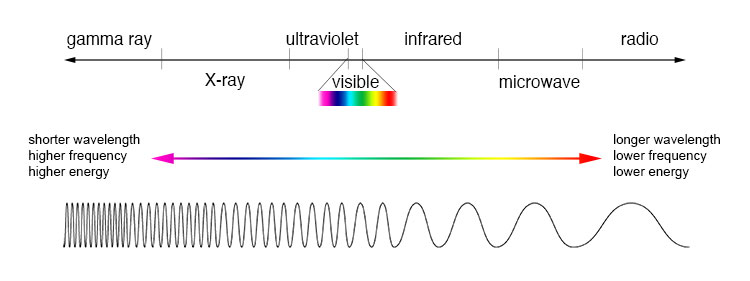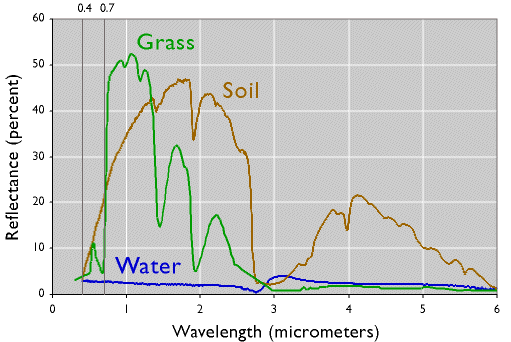|
|
Post by Andrew on Jan 22, 2016 13:03:46 GMT
if you look in a mirror, there is nothing in the mirror. You just see the light that came from yourself which is being directed back to you by what we call reflection. so you see the clouds via the water. There is nothing in or on the water as such called a reflection. The light just gets bent at the water. But i am not looking at light i an looking at heat and you can not see through glass with a thermal imager all you get is a very black image. Do you know about the electromagnetic spectrum?  Xrays Ultraviolet visible light infrared microwaves radio waves can all be reflected by a surface. What you detect when viewing the reflection is not 'in' the surface but rather an illusion created by the rays of energy being bent at the surface. |
|
|
|
Post by Andrew on Jan 22, 2016 13:06:16 GMT
 There is at least some amount of reflectance there which likely continues into the far infra red camera range. Supposedly dirty or turbid water is a better reflector of IR than clean water. Also i found that water was a good reflector at small angles of incidence much better than these charts suggest. There is a distinct difference between an I.R camera and a thermal i use both one requires either passive light eg starlite moonlight or 830-950nm added light thermal only picks up heat not light Sounds like you are talking about a short wave IR camera which relies on reflections from very hot objects or a source of short wave IR, and a standard thermal imagining camera which measures the temperature of a much cooler object which is producing long wave IR radiation. They are both IR cameras and both technically are thermal cameras but only very hot objects produce short wave IR while colder objects can only produce long wave IR. People talk about IR being invisible light. Sorry about the confusion. Interestingly for the global warming topic: www.sensorsinc.com/technology/why-swirUsing SWIR at night has another major advantage. An atmospheric phenomenon called night sky radiance emits five to seven times more illumination than starlight, nearly all of it in the SWIR wavelengths. So, with a SWIR camera and this night radiance - often called nightglow - we can "see" objects with great clarity on moonless nightsFrom further reading the total energy of this radiation is about the same as moonlight so it is a very weak heating energy. |
|
|
|
Post by fredzl4dh on Jan 23, 2016 9:35:52 GMT
Ir light of 7um is visible one of the reasons we don't use it for hunting as it can always be seen as a red glow but it has a longer throw than the 950um light which we use because it cannot be seen.The I.R camera we use is just an ordinary camera with the IR filter removed and we supply light with a 950um ir light which gives us a range of about 350 yards to shoot with.We use the thermal camera to locate deer which it will do out to 2 miles i could buy a thermal scope to do the both jobs but cost is prohibitive at 12,000nz dollars. Instead of the 400–700 nanometer range of the visible light camera, infrared cameras operate in wavelengths as long as 14,000 nm (14 µm). Their use is called thermography. Lot's of info here. en.wikipedia.org/wiki/Thermal_imaging_camera |
|
|
|
Post by Andrew on Jan 23, 2016 9:56:55 GMT
Ir light of 7um is visible one of the reasons we don't use it for hunting as it can always be seen as a red glow but it has a longer throw than the 950um light which we use because it cannot be seen.The I.R camera we use is just an ordinary camera with the IR filter removed and we supply light with a 950um ir light which gives us a range of about 350 yards to shoot with.We use the thermal camera to locate deer which it will do out to 2 miles i could buy a thermal scope to do the both jobs but cost is prohibitive at 12,000nz dollars. Instead of the 400–700 nanometer range of the visible light camera, infrared cameras operate in wavelengths as long as 14,000 nm (14 µm). Their use is called thermography. Lot's of info here. en.wikipedia.org/wiki/Thermal_imaging_cameraYou are calling the short wave infra red that you shine a light and saying the long wave infra red your thermal camera detects heat. infra red is sometimes called invisible light. All infra red can be called heat rays. The so called thermal cameras detect heat energy from warm objects *and* hot objects, because hot objects produce the same IR as warm objects as well as the IR only produced from hot objects. Your ordinary camera with the IR filter removed is only able to detect the IR heat energy from hot objects. So called heat rays begin at the far red and go all the way to the microwave region. So both cameras are 'heat ray' detecting cameras. But only one can detect 'heat rays' from a warm object. >>There is a distinct difference between an I.R camera and a thermal i use both one requires either passive light eg starlite moonlight or 830-950nm added light thermal only picks up heat not light Both detection methods are receiving IR 'heat rays' Only the so called thermal camera can pick up IR energy from both hot and warm objects |
|